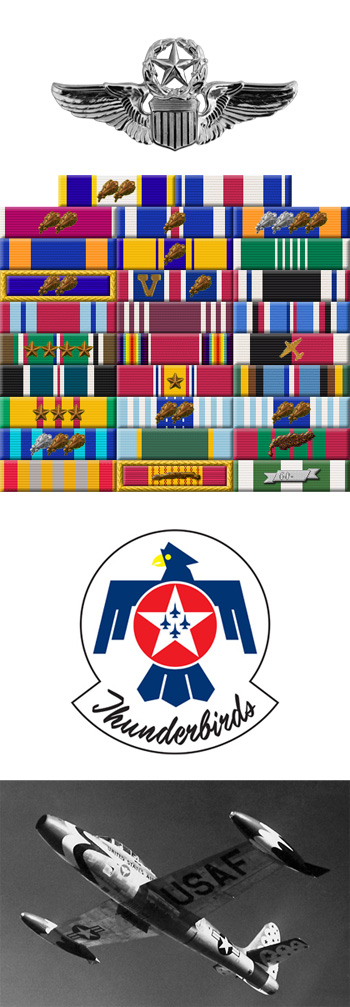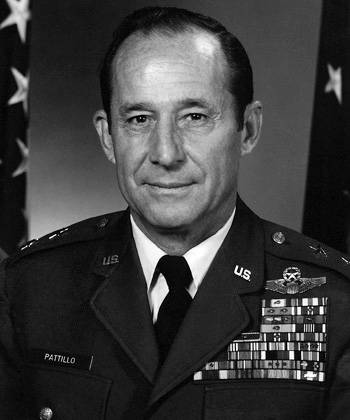
|
Cuthbert A. Pattillo |
 |
|||
| Rank, Service | ||||
Major General O-8, U.S. Air Force |
||||
| Veteran of: | ||||
|
||||
| Tribute: | ||||
Bill Pattillo was born on June 3, 1924, in Atlanta Georgia. He enlisted in the U.S. Army Air Forces on November 19, 1942, and entered the Aviation Cadet Program on February 1, 1943. Pattillo was commissioned a 2d Lt and awarded his pilot wings on March 12, 1944, and then completed P-40 Warhawk training before being assigned to the 487th Fighter Squadron of the 352nd Fighter Group in Europe, where he flew 135 combat missions in P-51 Mustangs from November 1944 until he was shot down over Germany and taken as a Prisoner of War on April 16, 1945. After being repatriated on May 2, 1945, Lt Pattillo returned to his squadron and left active duty on December 26, 1945. Before being shot down, Pattillo was credited with destroying 1 Me-262 jet fighter in aerial combat plus 6 enemy aircraft on the ground while strafing enemy airfields. He served in the Air Force Reserve until August 19, 1946, and then served in the Georgia Air National Guard until being recalled to active duty with the U.S. Air Force on March 26, 1948. Pattillo next served with the 31st Fighter Group at Turner AFB, Georgia, from March 1948 to January 1949, followed by flying F-80 Shooting Star and F-84 Thunderjet fighters with the 22dn Fighter Squadron of the 36th Tactical Fighter Wing at Furstenfeldbruck AB, Germany, from January 1949 to July 1952. During this time, Capt Pattillo assisted in organizing the Skyblazers, the U.S. Air Forces in Europe aerial demonstration team, where he flew right wing in over 250 air shows in Europe, Africa, and Asia. He then served as a gunnery instructor with the 3542nd Flying Training Squadron at Pinecastle AFB, Florida, from July 1952 to March 1953, followed by service with the 3600th Combat Crew Training Group at Luke AFB, Arizona, where he helped organize the Thunderbirds, the U.S. Air Force air demonstration team, flying right wing for the squadron's first season. Capt Pattillo then served as commander of the 3603rd Combat Crew Training Squadron at Luke AFB from June 1954 to November 1955, followed by service with the 613th Fighter-Bomber Squadron (FBS) of the 401st Tactical Fighter Wing at England AFB, Louisiana, until September 1957, when he became commander of the 615th FBS. He next received an Air Force Institute of Technology assignment to the University of Colorado, where he earned his bachelor's degree in mathematics in January 1962. His next assignment was with the 4450th Standardization and Evaluation Group at Langley AFB, Virginia, from February 1962 to August 1964, and he then attended Army War College from August 1964 to August 1965. Col Pattillo served as deputy commander for operations with the 50th TFW at Hahn AB, West Germany, from August 1965 to February 1967, followed by service as director of safety for the U.S. Air Forces in Europe at Lindsey AS, West Germany until August 1968, when he became vice commander of the 3rd TFW at Bien Hoa AB in the Republic of Vietnam. Col Pattillo became vice commander of the 31st TFW at Tuy Hoa AB, also in the Republic of Vietnam, in October 1968, and became its commander in February 1969, returning to the U.S. in October 1969. He then served on the staff of Headquarters Tactical Air Command at Langley AFB, Viriginia, followed by an assignment to U.S. Air Force Headquarters in the Pentagon from September 1972 to May 1974. Gen Pattillo next served as deputy chief of staff for operations and intelligence and senior U.S. representative to Allied Forces Central Europe, where he served from May 1974 to July 1977. His final assignment was as director of plans and policy for U.S. Readiness Command at MacDill AFB, Florida, where he served from July 1977 until his retirement from the Air Force on September 1, 1980. Bill Pattillo died on February 20, 2014, and will be buried at Arlington National Cemetery. |
||||
|
||||

